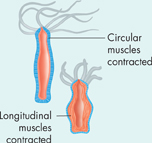28 Assessment
28.1 Response
Understand Key Concepts
Information received from the environment that causes an organism to respond is called a
response.
stimulus.
reaction.
trigger.
The simplest nervous systems are called
cephalopods.
motor neurons.
nerve nets.
sensory neurons.
In vertebrates, the part of the brain that coordinates body movements is the
olfactory lobe.
optic lobe.
cerebrum.
cerebellum.
The arrows in this diagram are pointing to which structures?

ganglia
brains
nerve nets
motor neurons
What two major trends in the evolution of the nervous system do invertebrates exhibit?
In general, how do the brains of mammals compare with the brains of other vertebrates? What is the significance of that difference?
What kinds of environmental stimuli are some animals capable of sensing that humans cannot sense?
Think Critically
Compare and Contrast List the three major types of neuron and compare their roles.
Apply Concepts Suppose a pet dog is having difficulty coordinating its movements. Why might a veterinarian X-ray the dog's brain?
28.2 Movement and Support
Understand Key Concepts
Which of the following animals uses a hydrostatic skeleton to move?
arthropod
sponge
fish
annelid
An arthropod's exoskeleton performs all of the following functions EXCEPT
production of gametes.
protection of internal organs.
support of the animal's body.
prevention of loss of body water.
Vertebrates have endoskeletons made of
chitin.
cartilage and/or bone.
calcium carbonate.
bone only.
Muscles generate force
only when they lengthen.
only when they shorten.
when they lengthen or shorten.
all the time.
How do a fish's muscles function when the fish swims?
Think Critically
Compare and Contrast List two advantages and two disadvantages of exoskeletons and endoskeletons.
Apply Concepts The diagrams below show a type of skeletal system found in invertebrates. What is the name for this type of skeleton? Describe how it functions.

Table of Contents
- Formulas and Equations
- Applying Formulas and Equations
- Mean, Median, and Mode
- Estimation
- Using Measurements in Calculations
- Effects of Measurement Errors
- Accuracy
- Precision
- Comparing Accuracy and Precision
- Significant Figures
- Calculating With Significant Figures
- Scientific Notation
- Calculating With Scientific Notation
- Dimensional Analysis
- Applying Dimensional Analysis




